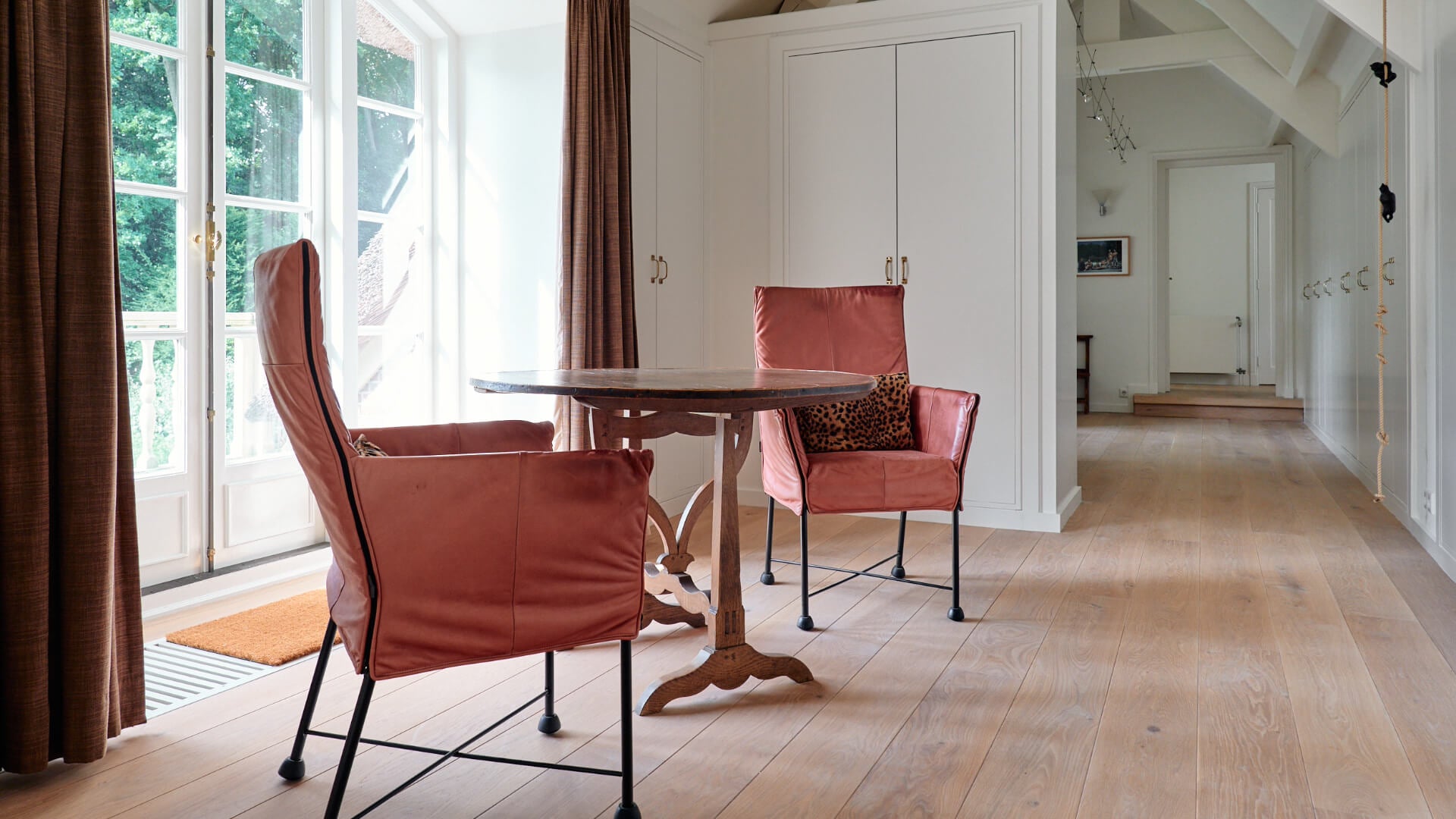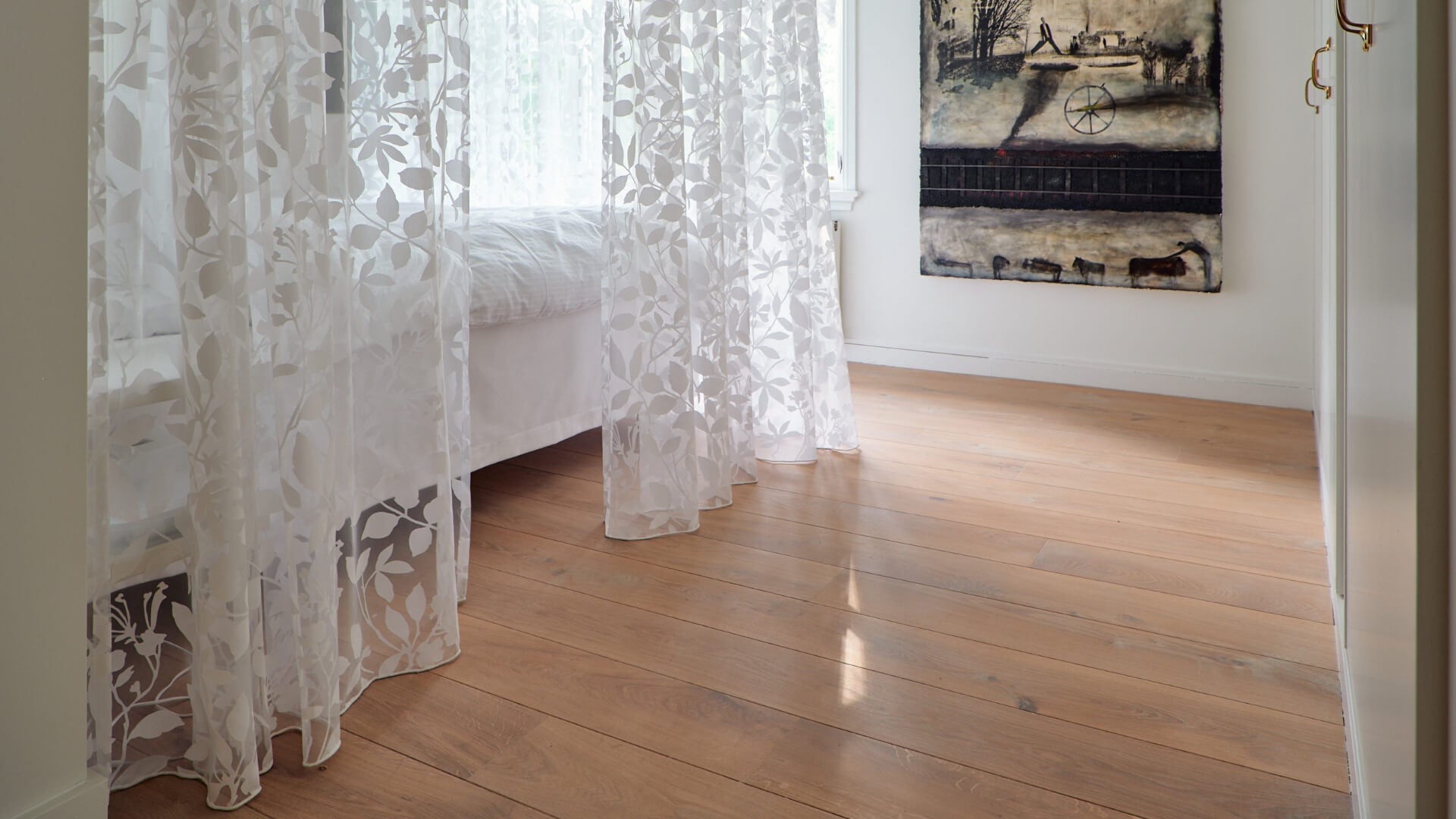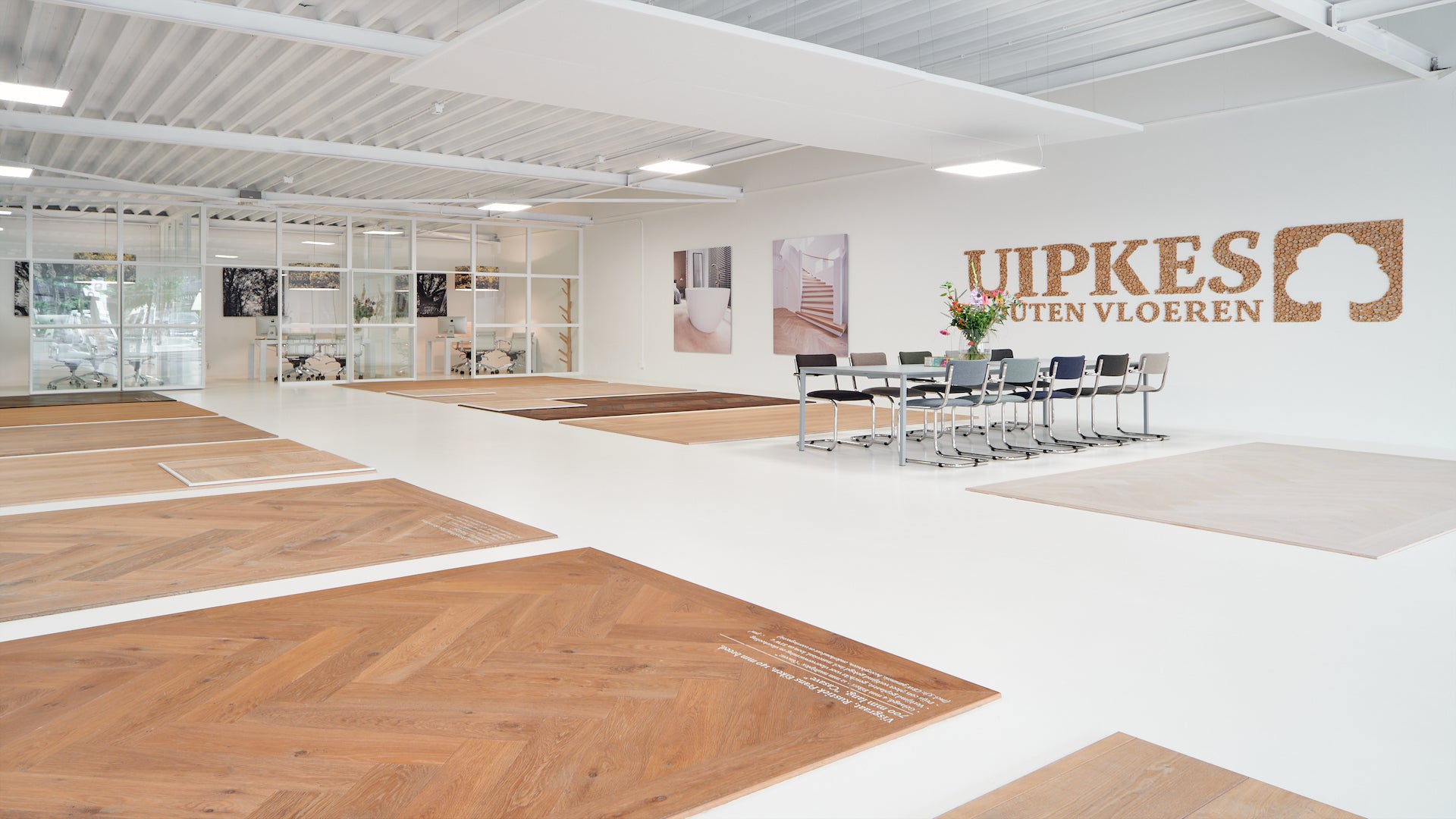Houten vloer schuren en behandelen

Bezoek de showroom
Wooden floors are lived and used extensively in everyday life. This may cause traces of use to become visible on the floor, such as scratches or damage. If maintenance oil no longer produces results, you can sand and treat the wooden floor. Even if the floor is still in good condition, you can choose to treat the wooden floor with a new color.
To restore or recolor a wooden floor, the floors can be treated with various products, such as oil, hard wax or varnish. By properly maintaining the floor you can enjoy the comfort of a wooden floor for longer. You can have our experienced parquet technicians sand and treat your wooden floor with oil or varnish.
Costs to treat wooden floors
You can treat a wooden floor with products such as oil, hard wax or varnish. With hard wax and varnish, a protective layer is applied to the wood. However, the oil is often polished into the wood, so there is no layer on the wood. Hard wax and lacquer can give the wood a shiny appearance, where oil gives a matte appearance.
The advantage of an oil compared to other products is that oil can be applied locally. The floor does not need to be sanded first.
The costs of sanding and oiling a wooden floor depend on the number of square meters. But in any case, it is much cheaper (and more sustainable) than replacing the wooden floor. You can also have optional work carried out. For example, consider replacing or repainting the skirting boards or covering a staircase in the same (new) color as the wooden floor.
- Costs of sanding and oiling a wooden floor: in addition to regularly vacuuming and wiping the floor, we at Uipkes Wood Flooring recommend periodic maintenance of the floor. Regular maintenance keeps the floor in good condition and you can enjoy it for a lifetime. This means that sanding the floor is no longer necessary.
- If desired, the floor can be sanded if the color changes or if there is similar damage. We can explain the options in a consultation or by sending an email to info@uipkes.nl. Sanding and oiling the floor costs approximately €36 per m2.
- Costs of sanding and varnishing a wooden floor: With a varnished floor, the protective layer is on top of the wood. This makes the floor closed against dirt and moisture. Over time, this may become damaged and bald spots may develop.
- The floor must always be sanded before you can apply a new layer of lacquer. The varnish is applied in three times, 1 time with base coat and 2 times with top coat. The floor should be lightly sanded in the meantime. Sanding and varnishing costs approximately €39 per m2.
A wooden floor from Uipkes Wood Flooring is always oiled. The floor no longer needs to be sanded and you get a floor for life.

Preparation for sanding and oiling
Do the following before the parquet installer starts working on you:
- Make sure you vacuum the floor thoroughly. Don't forget the radiators, they often contain a lot of dust that can end up on the floor during oiling.
- Remove skirting boards (including kitchen skirting boards), cables and furniture so that the parquet installer has easy access to everything.
- Prepare enough food and drinks if your wooden floor is also in the kitchen. The oil must dry thoroughly before you can walk on the floor. So you cannot access the kitchen.
- First test the new color on an area of the floor where furniture is normally located. This way you can see whether the new color meets your expectations before the entire floor is given the new color. The smoke treatment of the original floor can affect the new color.
After sanding and oiling
- Allow the oil to dry for at least 24 hours before walking on the floor.
- If you want to put down rugs, wait at least three weeks. This way the oil can harden properly.
- Do not slide heavy furniture across the floor during the first few weeks and place felt pads under furniture to prevent damage when sliding.
- Wait about two weeks before mopping.
Inspiratie & Informatie
A floor for life
You should sand and oil a Uipkes wooden floor if maintenance with the maintenance oil no longer produces the desired result or if you want to change the color. So you can consider treatment once every 20-25 years.
You can sand the wooden floors from Uipkes Wood Flooring 3-6 times (depending on the wood product). This means that a wooden floor from Uipkes will last a lifetime and it can even be a floor for the next generation!
Tip from Uipkes: Make sure there is a good mat near the door so that the worst dirt does not end up on the wooden floor. Place felt pads under tables, chairs and other furniture to protect the floor from damage. Check whether specialized parquet casters are installed on chairs.
More information?
Would you like more information about maintaining or sanding a wooden floor? Or would you like us to carry out the maintenance/sanding for you? Visit one of our showrooms in Alphen aan den Rijn, Amsterdam or Naarden. If you have any questions, please send an email to info@uipkes.nl.
Showrooms
Frequently Asked Questions
Can you repair minor damage to the floor?
If your wooden floor only has some minor damage, signs of wear or wear, it is usually not necessary to sand and oil the floor. It is then sufficient to clean the floor and then treat it with a maintenance oil. If it later turns out that this is not sufficient, you can always decide to sand and oil the floor.
Can you repair deep damage to your wooden floor?
The advantage of wooden floors finished with oil is that you can update them locally. You can therefore repair local, deep damage by only sanding the damaged wood and treating it with oil.
When is sanding and oiling or varnishing the wooden floor not an option?
If your wooden floor is damaged to such an extent that renovation no longer produces the desired effect, the floor must be replaced. This may be the case, for example, if several floor parts have bulged due to too much moisture.
In addition, cracks and shrinkage seams may appear in the floorboards if the wood has become too dry. This can happen if the humidity is below 40 percent for a long time. It is best to have a wooden floor specialist assess whether sanding and oiling is not an option.
How often can you sand a wooden floor?
That depends on the top layer of the wooden floor. Most wooden floors are made of engineered wood. A engineered wooden floor is a layered floor with a top layer of solid wood. The top layer is usually between 3 and 6 millimeters thick.
A floor with a top layer of 3 millimeters can logically be sanded less often than a floor with a top layer of 6 millimeters.
When is sanding and oiling the entire floor necessary?
Sanding and oiling the entire floor is necessary if the floor is poorly maintained or has wear spots and/or damage in several places. In addition, sanding and oiling the entire wooden floor is necessary if you want to give it a different color.
Wooden floors that have been finished with lacquer can only be sanded and varnished in their entirety. Local recovery is not possible.
Will you help clear the space for sanding and oiling?
Preparing to sand a wooden floor can be quite an undertaking if you have a lot of heavy furniture. We can help move furniture to another, ground-level room.
If this is not possible, we offer the option of sanding and oiling the floor in two steps by moving furniture to one side of a room and treating the other half of the floor later. Consult with our advisors to find a suitable solution.
Can the beveled edges be re-milled?
Yes that is possible. After we have sanded the floor, we use a milling machine to make the bevelled edges beautiful again, so that the floor as a whole looks sleek again.
What optional work can you carry out?
In addition to the wooden floor, we can also sand and oil other oak elements. Consider, for example, convector grilles, window sills and sills.
If you have the wooden floor sanded and oiled, it is worth considering re-cladding the stairs with wood and finishing it in the same color as the floor. In this way, the floor transitions seamlessly to the stairs and together they form a beautiful whole.
Can I sand and oil/varnish the wooden floor myself?
The most important advantage of sanding and oiling/varnishing your wooden floor yourself is that you save on the labor costs of a parquet installer . But on the other hand, there are the following disadvantages:
- The chance that you will make mistakes when sanding is quite high. For example, you need to know how to properly adjust the sander, otherwise you can damage the wooden floor.
- If you cause damage, you still have to call in a parquet installer to repair the damage. You will then spend more money than if you had outsourced the sanding and oiling.
- You incur costs to rent a sander.
- Treating the wooden floor with oil and giving it the desired color can be quite a challenge. Previous treatments of the wooden floor can influence the end result.
- Sanding and oiling yourself takes a lot of time, especially if you have never done it before.
Can I outsource the sanding and oiling/varnishing of the wooden floor?
Are you dreading applying the maintenance oil? Then we can help you with this. We can take care of the maintenance for you periodically or over a longer period. The advantages at a glance:
- The same experienced parquet technicians who install the floors provide the treatments.
- The treatment is carried out professionally: The floor parts will be well protected again. The floor will be as good as new again.
- During the treatment, the floor is checked for damage and minor repairs are resolved free of charge.
Gezien de voor- en nadelen is het in de meeste gevallen het meest verstandig om je houten vloer door een parquet installer te laten schuren en oliën. Als je het per se zelf wilt doen, neem dan eerst de tijd om je goed in te lezen in hoe je het werk moet uitvoeren. Wil je jouw houten vloeren voorzien van een unieke Uipkes kleur of een nieuwe houten vloer kopen? Kom langs in één van onze showrooms of stuur een mail naar info@uipkes.nl.


